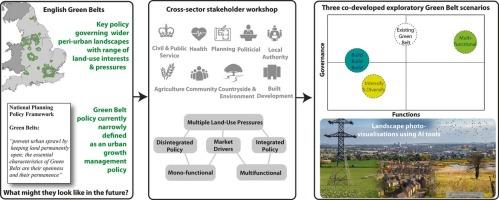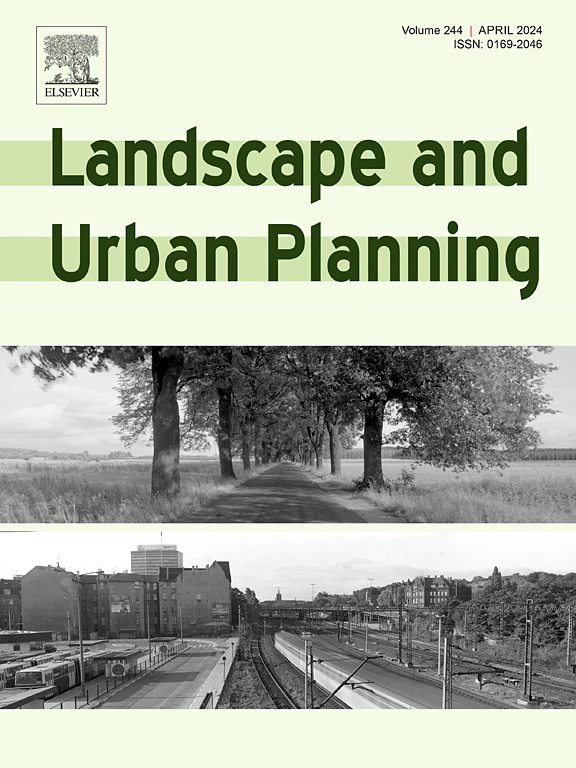A greener Green Belt? Co-developing exploratory scenarios for contentious peri-urban landscapes
IF 7.9
1区 环境科学与生态学
Q1 ECOLOGY
引用次数: 0
Abstract
Peri-urban landscapes experience conflicting land-use demands from co-occurring urban–rural drivers. In England, Green Belts are urban containment policies which impact on the peri-urban in isolation from the wider landscapes they cover. Green Belts’ endurance in planning policy have resulted in a contentious and politicised policy arena, under significant scrutiny. Whilst research has shown heterogeneous supplies of ecosystem services existing in Green Belts, it is unclear how and whether Green Belts as landscapes may change in the future beyond their urban containment bounds. Though participatory scenarios have been extensively applied to landscape planning, they have not to English Green Belts. Addressing these gaps, a cross-sector stakeholder workshop was held to co-develop exploratory Green Belt landscape scenarios nationally in 20 years’ time. Three scenarios: “Intensify & Diversify”, “Build-Build-Build” and “Multifunctional” were framed on a governance-functionality axis, identifying future drivers, impacts and assumptions. The scenarios reveal Green Belts are under increased pressure from multiple land-uses, societal demands, and policies, many of which are in conflict, stemming from either a prioritisation or balancing of these demands through varying governance mechanisms. Stakeholder critiques and visions reveal a substantial cross-sector consensus for more (multi)functional Green Belts in England, including as “strategic urban support landscapes” to adapt and mitigate threats associated with climate change. Finally, complementary landscape photo-visualisations of “fictitious” landscapes were produced, aided by artificial intelligence, highlighting the growing potential of these tools to support landscape research. This use of fictional landscapes extends the applicability of our results to peri-urban areas experiencing comparable contexts and drivers, such as Western and Northern European regions.

更环保的绿带?共同开发有争议的城市周边景观的探索性场景
城市周边景观经历了城乡共同驱动因素的土地使用需求冲突。在英国,绿带是城市遏制政策,它对城市周边地区的影响与它们所覆盖的更广泛的景观隔离开来。“绿带”在规划政策上的持久性导致了一个有争议和政治化的政策舞台,受到了严格的审查。虽然研究表明,绿化带中存在异质性的生态系统服务供应,但目前尚不清楚作为景观的绿化带在未来如何以及是否会超出其城市遏制范围而发生变化。虽然参与式场景已被广泛应用于景观规划中,但尚未应用于英国绿化带。为了解决这些差距,举办了一个跨部门利益相关者研讨会,共同开发20年后全国绿带景观的探索性方案。三种情况:“加强& &;“多样化”、“建设-建设-建设”和“多功能”以治理-功能为轴心,确定了未来的驱动因素、影响和假设。这些情景表明,绿带面临着来自多种土地用途、社会需求和政策的越来越大的压力,其中许多是相互冲突的,这源于通过不同的治理机制来优先考虑或平衡这些需求。利益相关者的批评和愿景揭示了一个重要的跨部门共识,即在英格兰建立更多(多)功能的绿化带,包括作为“战略城市支持景观”,以适应和减轻与气候变化相关的威胁。最后,在人工智能的帮助下,制作了“虚拟”景观的互补景观照片可视化,突出了这些工具支持景观研究的日益增长的潜力。这种虚构景观的使用将我们的结果扩展到具有类似背景和驱动因素的城郊地区,如西欧和北欧地区。
本文章由计算机程序翻译,如有差异,请以英文原文为准。
求助全文
约1分钟内获得全文
求助全文
来源期刊

Landscape and Urban Planning
环境科学-生态学
CiteScore
15.20
自引率
6.60%
发文量
232
审稿时长
6 months
期刊介绍:
Landscape and Urban Planning is an international journal that aims to enhance our understanding of landscapes and promote sustainable solutions for landscape change. The journal focuses on landscapes as complex social-ecological systems that encompass various spatial and temporal dimensions. These landscapes possess aesthetic, natural, and cultural qualities that are valued by individuals in different ways, leading to actions that alter the landscape. With increasing urbanization and the need for ecological and cultural sensitivity at various scales, a multidisciplinary approach is necessary to comprehend and align social and ecological values for landscape sustainability. The journal believes that combining landscape science with planning and design can yield positive outcomes for both people and nature.
 求助内容:
求助内容: 应助结果提醒方式:
应助结果提醒方式:


